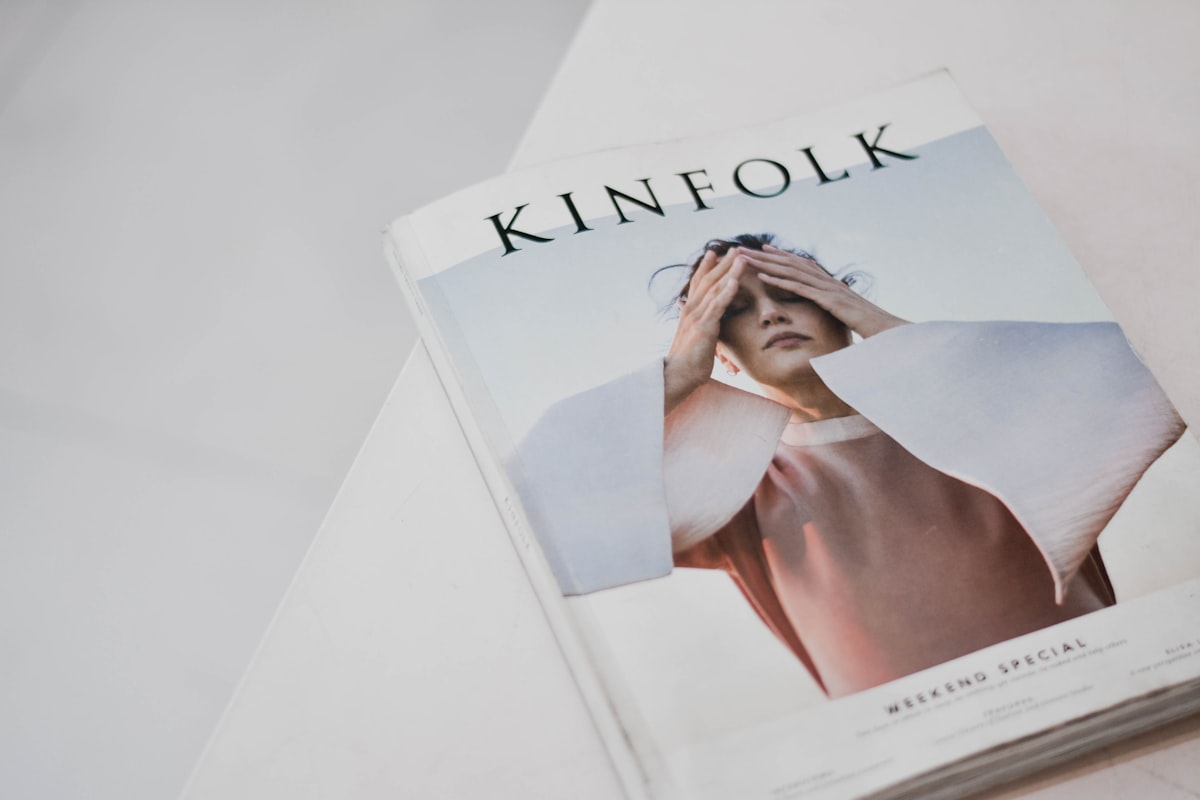Confessions Of A Kinfolk Reader

I must confess that when I visit libraries, I always borrow magazines. I like many of them, but the one I adore is Kinfolk.
The folks at Kinfolk have mastered a lost art: they know how to soothe the soul of the modern reader by bringing back the magic of craftsmanship.
Kinfolk has garnered a cult-like following among millennials for its cause of intentional living. As one flips through the pages of Kinfolk, one feels the heft of the paper, the austerity of the pictures and the meticulousness of its editors.
They are the Sherpas to the weary urban souls, inviting them to once again discover the joys of slow living in an increasingly fast-paced world. Their whispers are carried across 100 countries in four languages to hundreds of thousands of readers.
I suspect critics may sneer at Kinfolk for enabling pretentious millennials. This charge has a modicum of justice: Kinspiracy is a Tumblr site dedicated to mocking hipsters posting redundant content for the minimalist vibes.
After all, who doesn't like a cup of overpriced latte, a thin slice of avocado toast with a poached egg on their Instagram feed? (I have to confess, I chuckled a little too hard at their byline.)
However, criticising Kinfolk for the commodification of their aesthetic by others is as absurd as blaming BMW for car accidents. More importantly, it misses out on the aspiration of slow living that Kinfolk seeks to cultivate.
Workers Of The World, Slow Down

“Spending more time with friends and family costs nothing. Nor does walking, cooking, meditating, making love, reading or eating dinner at the table instead of in front of the television. Simply resisting the urge to hurry is free.” - Carl Honore
In 1986, when McDonald's opened a branch beside the famous Spanish Steps in Rome, many locals were outraged. These steps were metaphorically and literally, a stairway to the divine. To open a fast-food restaurant, an icon of modern consumerism right at the foot of Trinita Dei Monti Church (pictured above), was one step too far.
If Karl Marx were alive, he would have called for 'the workers of the world to unite in revolution' and 'let the ruling classes tremble at a Communistic revolution.'
In typical Italian fashion, they fought food with food. In Rome, Carlo Petrini, a charismatic culinary writer, launched Slow Food to counter the onslaught of the fast-food tsunami sweeping across the world. Through elegant words and taste, he called for the world's workers to slow down, to recover the lost art of artisanship in an industrial age.
Slow food was the antithesis to McDonald's: fresh and local seasonal produce, traditional recipes, and sustainable farming that would endure across generations, artisanal production and relaxed dining with loved ones.
“One cannot think well, love well, sleep well, if one has not dined well.”- Virginia Woolf
From slow food, the movement of slow living was born. The response to mainstream consumerism and the frantic pace of modern capitalism is not a revolution by savagery but a revolution by serenity. Slow living preaches intentionality and nudges people towards immersing themselves in their immediate sensory experiences.
In this spirit, Kinfolk was born.
Kinfolk does not depend on hedonism, voyeurism or clickbait to make its dent in the universe. What Kinfolk offer their readers are intimate portraits (of people and spaces), design ideas and occasionally, advice on slow living.
The instinct of Kinfolk is towards immersion. From the heft of the magazines to the textures of the page and the stories they tell, you are induced to slow down. They are so committed to your immersion that they tirelessly swim against the tide of the industry by resisting the temptation of advertisements and publishing watered-down monthly versions.
In essence, just as Petrini's craft was gastronomy, Kinfolk's craft is publishing.
Always Breathing

I often read books that I wished I could 'Kinfolkize', and I would find it much more readable. We have a glut of 300-page books that could have been halved or turned into an essay. It's as if many of these authors are trying to show their readers how complex their ideas are or how smart they are, rather than communicating to their readers. Kinfolk essays are always concise, focused and beautiful. In particular, I admire the artistry of the authors.
First, the way they use white space on their pages - a delectable mix of varying serif fonts splashed sparingly on a cream canvas invites your eyes to saunter through the essay. (I always look at each page as if it were a work of art.)
Second, the exquisite way they craft their bylines on each article. They pique your curiosity - and they promise to satisfy it by the time your eyes reaches the last full stop.
Consider this,
Creating an oasis of calm in a towering urban metropolis may be challenging, but by slightly changing the way we think, we can learn to appreciate the advantages of both the rapid and slow paces of life.
How can one not be seduced to read on? Such words could even ward off the itch of scrolling mindlessly on Instagram or Tiktok.
As a young civil servant hoping to impress and influence my team, I live and die by the keyboard. I have learned that if one could write the first five sentences well, one could earn the undivided attention of his reader for the next minute. As good practice in learning how to paint with words, I often study Kinfolk essays.
Third, they breathe life into the mundane. When a magazine chooses brand consistency, it runs the risk of falling into the traps of banal tropes. The Kinfolk Home, in particular, is a masterclass in managing the dichotomy of consistency and novelty. They featured a total of thirty-five homes, all with a minimalist slant. Yet, the people inhabiting the different homes explore a different facet of slow living and incorporate their quaintness and tastes into their abodes. As a result, the book felt like a potluck where I, as the reader, was invited to feast in it.
The sneak peeks I was afforded through the magazine made these everyday people inspiration to me, a future (hopefully) homeowner.
Indeed, like many lifestyle magazines (and novels, Hollywood movies, especially chick flicks, and self-help books), Kinfolk sells the fiction of aspiration. But in those fifteen minutes of flipping those pages, I am compelled to suspend my disbelief and enjoy the curation of these beautiful portraits of imperfect people and imperfect homes.
The writers guide me along with the stories of strangers without the infuriating interruptions of unwarranted advertisements asking me to buy a couch I cannot afford, and I bless their hearts for it.
A Gentle Whisper to Action

A gentle word, a kind look, a good-natured smile can work wonders and accomplish miracles. - William Hazlit
Many self-help books promise you an answer to your life's problems. They tell you that successful people wake up at 5AM, that if you have the right habits, life will be rosy. With their books, success will no longer elude you and Lady Luck will shine upon you.
"The only way to get rich from a self-help book is to write one."
The air of authority and moral superiority coupled with the tired, clickbait punchlines has repelled me from self-help books in general.
In an ironic twist of fate, this lifestyle magazine has been helpful in changing my life for the better. For starters, the writers detail the imperfections of urban life vividly and recognize how little we truly control in our own lives.
Yet, Kinfolk encourages a celebration of these imperfections and advocates to you the joys of slow living. There are no hacks, no sure-fire ways to success. Yes, there are little tips and tricks peppered throughout the magazine but there come wrapped in anecdotes, gently whispering an invite to you to playfully experiment with what is best for you.
Here is one of my favourite pieces of advice on staycations.
- On Dining In. Some recipes require several days and a whole lot of patience to bring to fruition - and that means several successive days you don't typically have to spend in the kitchen up to your elbows in dough. So have a whirl at curing your own meat or fish. Soak a variety of dried grains, Make your own puff pastry. Take some time to master the dishes your grandparents made from scratch and enjoy these lengthy methods instead of trying to speed up things. If you want to take your culinary holiday to the next level, get creative and theme every day's meals around a different concept- like a country or colour and munch only foodstuff relating to that notion.
From the amateur to the chef-extraordinaire, there is something in it for everyone. After reading this paragraph, are you not inclined to try cooking your own nasi lemak or fish & chips?
After all, who are the people featured in their magazines?
They are not billionaires on the covers of Forbes.
They are not Hollywood actors on the covers of Men/Women's Health.
They are not pop singers on the covers of Rolling Stone.
They are everyday people, they are kinfolk.